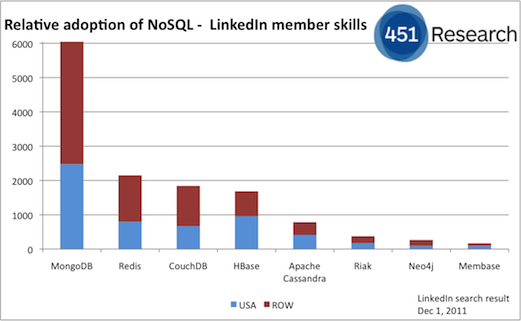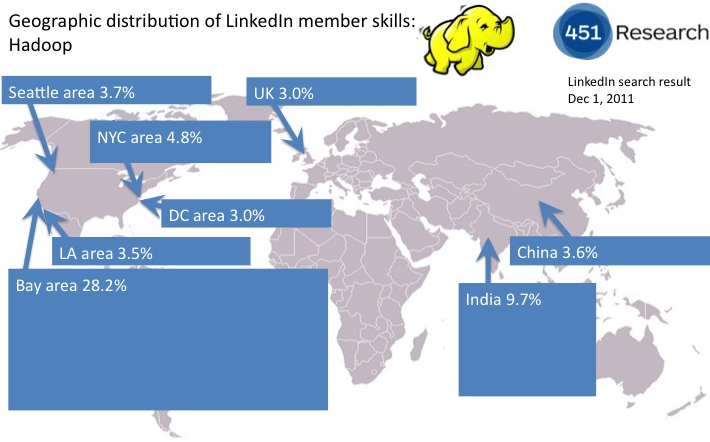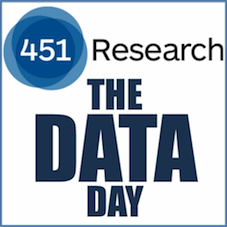March 26th, 2013 — Data management
As Q1 comes to a close its time to take another look at our NoSQL LinkedIn Skills Index, based on the number of LinkedIn member profiles mentioning each of the NoSQL projects. This is the second update since we rebooted the analysis in September 2012 to account for more products and refine our search terms.

A few interesting statistics to pick out: Neo4j has, as predicted, jumped ahead of MarkLogic for sixth place. No other changes of position, but outside the top ten, shown here, Apache Accumulo continues to grow well.
In fact, Apache Accumulo had the fastest rate of growth for the second quarter in succession, just ahead of DynamoDB and OrientDB -once again – followed by Apache Cassandra and MongoDB.
MongoDB’s growth means that it once again extended its lead as the most popular NoSQL database, according to LinkedIn profile mentions. As the chart below illustrates, it now accounts for 46% of all mentions of NoSQL technologies in LinkedIn profiles, according to our sample, compared with 45% in December.

January 28th, 2013 — Data management
Informatica’s revenue is in. Hortonworks joins OpenStack. And more.
And that’s the Data Day, today.
January 10th, 2013 — Data management
451 Research’s 2013 Database survey is now live at http://bit.ly/451db13 investigating the current use of database technologies, including MySQL, NoSQL and NewSQL, as well as traditional relation and non-relational databases.

The aim of this survey is to identify trends in database usage, as well as changing attitudes to MySQL following its acquisition by Oracle, and the competitive dynamic between MySQL and other databases, including NoSQL and NewSQL technologies.
There are just 15 questions to answer, spread over five pages, and the entire survey should take less than ten minutes to complete.
All individual responses are of course confidential. The results will be published as part of a major research report due during Q2.
The full report will be available to 451 Research clients, while the results of the survey will also be made freely available via a
presentation at the Percona Live MySQL Conference and Expo in April.
Last year’s results have been viewed nearly 55,000 times on SlideShare so we are hoping for a good response to this year’s survey.
One of the most interesting aspects of a 2012 survey results was the extent to which MySQL users were testing and adopting PostgreSQL. Will that trend continue or accelerate in 2013? And what of the adoption of cloud-based database services such as Amazon RDS and Google Cloud SQL?
Are the new breed of NewSQL vendors having any impact on the relational database incumbents such as Oracle, Microsoft and IBM? And how is SAP HANA adoption driving interest in other in-memory databases such as VoltDB and MemSQL?
We will also be interested to see how well NoSQL databases fair in this year’s survey results. Last year MongoDB was the most popular, followed by Apache Cassandra/DataStax and Redis. Are these now making a bigger impact on the wider market, and what of Basho’s Riak, CouchDB, Neo4j, Couchbase et al?
Additionally, we have been tracking attitudes to Oracle’s ownership of MySQL since the deal to acquire Sun was announced. Have MySQL users’ attitudes towards Oracle improved or declined in the last 12 months, and what impact will the formation of the MariaDB Foundation have on MariaDB adoption?
We’re looking forward to analyzing the results and providing answers to these and other questions. Please help us to get the most representative result set by taking part in the survey at http://bit.ly/451db13
December 18th, 2012 — Data management
Time again to take a look at our NoSQL LinkedIn Skills Index, based on the number of LinkedIn member profiles mentioning each of the NoSQL projects. This is the first update since we rebooted the analysis in September to account for more products and refine our search terms.

On the face of it not a lot has changed in the last quarter, although there are a few interesting statistics to pick out. For instance, Neo4j is now practically tied for sixth place with MarkLogic and can be expected to overtake it in Q1 2013. Outside the top ten shown above, Apache Accumulo has gained two places – overtaking Aerospike and Hypertable.
In fact, Apache Accumulo showed the fastest rate of growth in mentions between September and December, just ahead of DynamoDB and OrientDB, followed by Couchbase and MongoDB.
MongoDB’s growth means that it has cemented its place as the most popular NoSQL database, according to LinkedIn profile mentions. As the chart below illustrates, it now accounts for 45% of all mentions of NoSQL technologies in LinkedIn profiles, according to our sample, compared with 43% in September.

October 4th, 2012 — Data management
SkySQL goes cloud. RainStor raises $12m. And more
And that’s the Data Day, today.
April 19th, 2012 — Data management
March 27th, 2012 — Data management
Back in December we ran a series of posts looking at the geographic distribution of NoSQL skills, according to the results of searching LinkedIn member profiles, culminating in a look at the relative overall popularity of the major NoSQL databases.
This week I took another look at LinkedIn to update the results for a forthcoming report, which gives us the opportunity to see how the results have changed over the past quarter:

While this provides us with an interesting opportunity to track LinkedIn profile mentions over time there isn’t a huge amount we can learn from this first update – other than that MongoDB seems to be increasing its dominance.
The only significant change that isn’t immediately obvious from looking at the chart is that Apache HBase has overtaken Apache CouchDB by a tiny margin to claim third place overall.
As we noted last time, however, Apache HBase is more reliant on the US than other NosQL databases for its LinkedIn mentions: it is the second most prevalent NoSQL database mentioned in the USA but fourth in the rest of the world.
Two other points to take into consideration:
– The results for Apache Cassandra are probably disproportionately low since we have to search for the full phrase in order to avoid including people called Cassandra.
– Previously we only searched for Membase. This time we added together the search results for both Membase and Couchbase. This may mean the result for Couch/Membase is disproportionately high since some members probably listed both.
This is not meant to be a comprehensive analysis, however, but rather a snapshot of one particular data source.
December 12th, 2011 — Data management
Hidden away amongst the details of our little tour around LinkedIn statistics on NoSQL and Hadoop skills was some interesting information on how many LinkedIn members list the various data management technologies in our sample in their profiles.
Our original post contained the fact that there were 9,079 LinkedIn members with “Hadoop” in their member profiles, for example, compared to 366,084 with “MySQL” in their member profiles.
Later posts showed there were 170 with “Membase” and 1,687 with “HBase”, 787 with “Apache Cassandra” and 376 with “Riak”, 6,048 with “MongoDB” and 2,152 with “Redis”, and finally, 1,844 with “CouchDB” and 268 with “Neo4j”.
This gives us an interesting perspective on the relative adoption of the various NoSQL databases:

If it wasn’t already obvious from the list above, the chart illustrates just how much more prevalent MongoDB skills are compared to the other NoSQL databases, followed by Redis, Apache CouchDB, Apache HBase and Apache Cassandra. The chart also illustrates that while HBase is the second most prevalent NoSQL skill set in the USA, it is only fourth overall given its lower prevalence in the rest of the world.
In response, a representative from a certain vendor notes “Some skills are more valued not because they are more prevalent, but because they are harder to achieve.” Make of that what you will.
December 9th, 2011 — Data management
Following last week’s post putting the geographic distribution of Hadoop skills, based on a search of LinkedIn members, in context, this week we will be publishing a series of posts looking in detail at the various NoSQL projects.
The posts examine the geographic spread of LinkedIn members citing a specific NoSQL database in their member profiles, as of December 1, and provides an interesting illustration of the state of adoption for each.
We’ve already taken a look at Membase and HBase; Apache Cassandra and Riak; and 10gen’s MongoDB and Redis.
Part four brings the series to a close with a look at Apache CouchDB and Neo4j, which boast the most geographically diverse adoption of the NoSQL databases in our sample.
The statistics showed that 36.4% of the 1,844 LinkedIn members with “CouchDB” in their member profiles are based in the US, while only 8.9% are in the Bay area, the least of any of the NoSQL database we looked at.
The results also indicate that the UK is a particularly strong area for CouchDB skills, with 7.1%. Other hot-spots include Canada (4.1%), Germany (4.0%) and The Netherlands (3.1%).

Neo4j is even more widely adopted, with only 36.2% of the 268 LinkedIn members with “Neo4j” in their member profiles based in the US, although 10.4% are in the Bay area.
With 4.1%, Sweden is a hot-spot for Neo4j skills, as one might expect given that’s where it and Neo Technology originated. The UK is also strong with 9.7%, followed by India with 5.6% and the New York area with 4.9%.
Since Neo4j originated in Europe it is of course an open question whether its higher adoption in the Rest of the World than the US is a sign of a greater spread of adoption, or a relative failure to infiltrate the US market. Given that the company already has an active presence in the US we are inclined towards the former.

N.B. The size of the boxes is in proportion to the search result (click each image for a larger version). World map image: Owen Blacker
December 2nd, 2011 — Data management
NC State University’s Institute for Advanced Analytics recently published some interesting statistics on Apache Hadoop adoption based on a search of LinkedIn data.
The statistics graphically illustrate what a lot of people wer already pretty sure of: that the geographic distribution of Hadoop skills (and presumably therefore adoption) is heavily weighted in favour of the USA, and in particular the San Francisco Bay Area.
The statistics showed that 64% of the 9,079 LinkedIn members with “Hadoop” in their member profiles (by no means perfect but an insightful measure nonetheless) are based in the US, and that the vast majority of those are in the Bay Area.
The results are what we would expect to see given the relative level of immaturity of Apache Hadoop adoption, as well as the nature and location of the early Hadoop adopters and Hadoop-related vendors.
The results got me thinking two things:
– how does the geographic spread compare to a more maturely adopted project?
– how does it compare to the various NoSQL projects?
So I did some searching of LinkedIn to find out.
To answer the first question I performed the same search for MySQL, as an example of a mature, widely-adopted open source project.
The results show that just 32% of the 366,084 LinkedIn members with “MySQL” in their member profiles are based in the US (precisely half that of Hadoop) while only 4.4% are in the Bay area, compared to 28.2% of the 9,079 LinkedIn members with “Hadoop” in their member profiles.
The charts below illustrate the difference in geographic distribution between Hadoop and MySQL. The size of the boxes is in proportion to the search result (click each image for a larger version).


With regards to the second question, I also ran searches for MongoDB, Riak, CouchDB, Apache Cassandra*, Membase*, Neo4j, Hbase, and Redis.
I’ll be posting the results for each of those over the next week or so, but in the meantime, the graphic below shows the split between the USA and Rest of the World (ROW) for all ten projects.
It illustrates, as I suspected, that the distribution of skills for NoSQL databases is more geographically disperse than for Hadoop.
I have some theories as to why that is – but I’d love to hear anyone else’s take on the results.

*I had to use the ‘Apache’ qualifier with Cassandra to filer out anyone called Cassandra, while Membase returned a more statistically relevant result than Couchbase.
World map image: Owen Blacker














 Subscribe via RSS
Subscribe via RSS